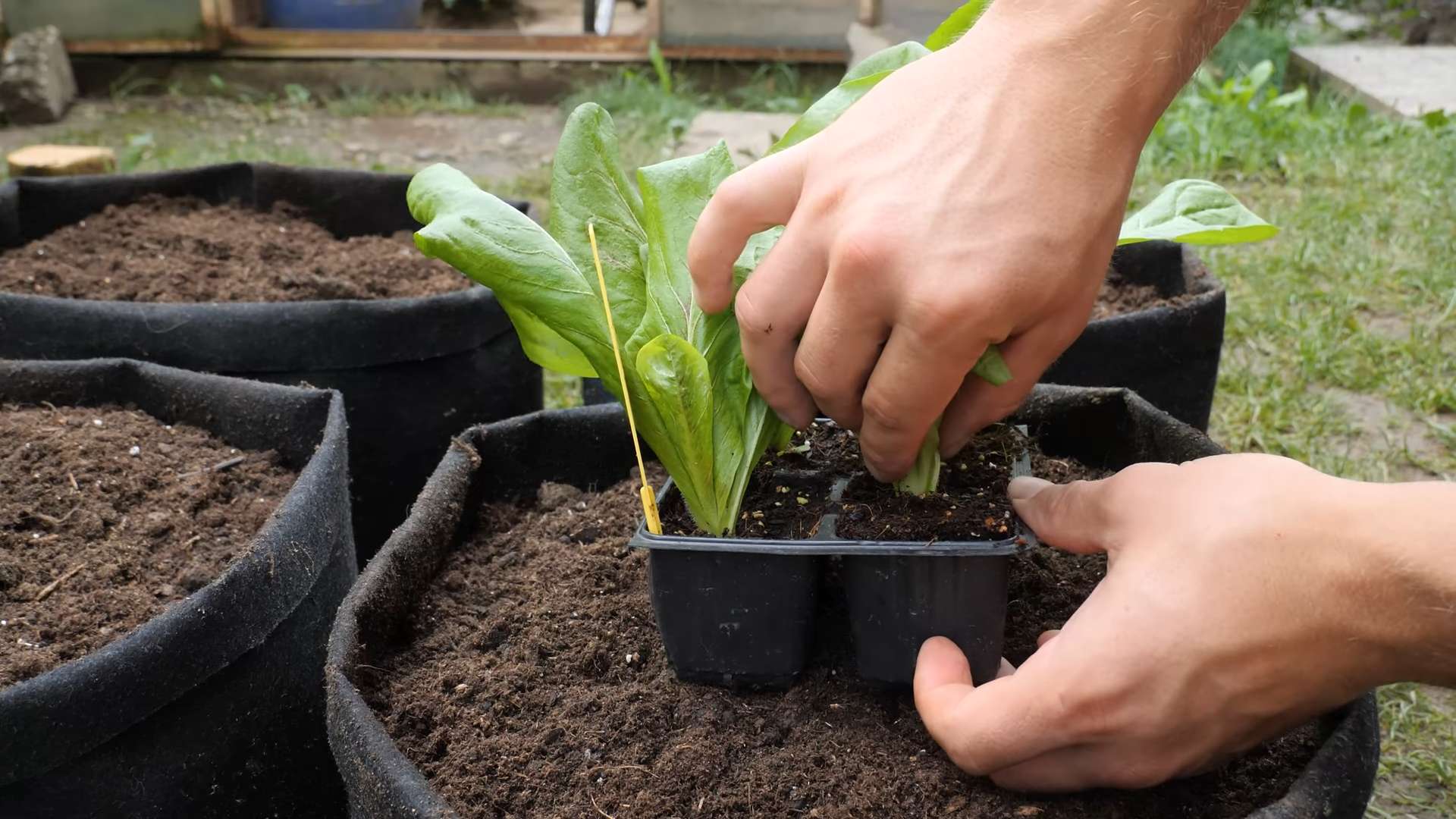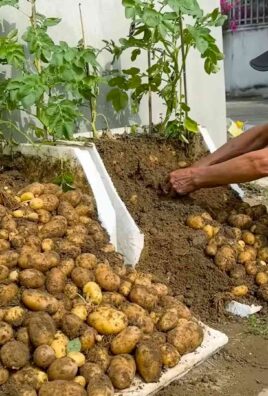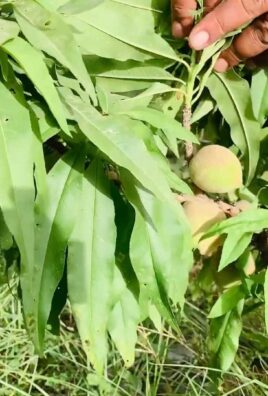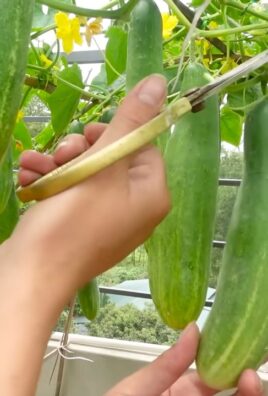Growing Radicchio in Pots might sound intimidating, but trust me, it’s easier than you think! Have you ever admired those vibrant, burgundy leaves in the grocery store and wished you could harvest your own fresh supply? Well, you absolutely can, even without a sprawling garden. For centuries, radicchio has been a staple in Italian cuisine, adding a delightful bitter note to salads and grilled dishes. Its origins trace back to the Veneto region of Italy, where it’s been cultivated and celebrated for its unique flavor and nutritional benefits.
But why bother growing radicchio in pots yourself? Simple! Store-bought radicchio can be expensive and often lacks the freshness and flavor of homegrown varieties. Plus, there’s something incredibly satisfying about nurturing a plant from seed to table. In this article, I’m going to share my favorite DIY tricks and hacks for successfully growing radicchio in containers, even if you’re a complete beginner. We’ll cover everything from choosing the right pot and soil to watering and harvesting techniques. Get ready to enjoy the taste of Italy right from your own patio!

Growing Radicchio in Pots: A Beginner’s Guide
Okay, so you want to grow radicchio in pots? Awesome! It’s totally doable, even if you don’t have a sprawling garden. Radicchio, with its beautiful burgundy leaves and slightly bitter flavor, adds a touch of sophistication to any salad. Plus, it’s surprisingly easy to grow in containers. I’m going to walk you through everything you need to know, from choosing the right pot to harvesting your delicious, homegrown radicchio.
What You’ll Need
Before we dive in, let’s gather our supplies. This is a pretty straightforward project, so you probably already have a lot of this stuff on hand.
* Radicchio Seeds: Obviously! Choose a variety that you like. Some common ones are ‘Chioggia’, ‘Treviso’, and ‘Castelfranco’. I personally love ‘Chioggia’ for its classic round shape and vibrant color.
* Pots: You’ll need pots that are at least 6-8 inches deep and wide. Radicchio needs room for its roots to develop. I prefer using terracotta pots because they allow for good drainage, but plastic pots work just fine too. Just make sure they have drainage holes!
* Potting Mix: Don’t use garden soil! It’s too heavy and doesn’t drain well in containers. Opt for a high-quality potting mix that’s specifically formulated for container gardening. I like to use a mix that contains peat moss, perlite, and vermiculite.
* Watering Can or Hose: For, well, watering! A gentle watering can is ideal, especially when the seedlings are young.
* Fertilizer (Optional): A balanced liquid fertilizer can help boost growth, but it’s not strictly necessary. I usually use a diluted fish emulsion fertilizer every few weeks.
* Small Trowel or Hand Shovel: For planting and transplanting.
* Labels (Optional): If you’re growing multiple varieties, labels will help you keep track of which is which.
Getting Started: Sowing the Seeds
The first step is to get those seeds started! You can either start them indoors or directly sow them into your pots, depending on your climate and the time of year.
Starting Seeds Indoors (Recommended for Cooler Climates)
Starting seeds indoors gives you a head start, especially if you live in a region with a short growing season.
1. Fill Seed Trays or Small Pots: Fill your seed trays or small pots with potting mix. Moisten the soil gently.
2. Sow the Seeds: Sow the radicchio seeds about 录 inch deep. I usually plant 2-3 seeds per cell or pot, just in case some don’t germinate.
3. Cover and Water: Lightly cover the seeds with potting mix and gently water them.
4. Provide Light: Place the seed trays or pots in a warm, sunny location or under grow lights. Radicchio seeds need light to germinate.
5. Keep Moist: Keep the soil consistently moist, but not soggy. You can use a spray bottle to mist the soil.
6. Thin Seedlings (If Necessary): Once the seedlings emerge (usually in 5-10 days), thin them to one seedling per cell or pot. Choose the strongest, healthiest-looking seedling.
Direct Sowing (Suitable for Warmer Climates)
If you live in a warmer climate and the soil has warmed up, you can sow the seeds directly into your pots.
1. Prepare the Pots: Fill your pots with potting mix and moisten the soil.
2. Sow the Seeds: Sow the radicchio seeds about 录 inch deep, spacing them about 2-3 inches apart.
3. Cover and Water: Lightly cover the seeds with potting mix and gently water them.
4. Keep Moist: Keep the soil consistently moist until the seeds germinate.
5. Thin Seedlings: Once the seedlings emerge, thin them to one seedling every 6-8 inches.
Transplanting (If Starting Indoors)
Once your seedlings have developed a few sets of true leaves (the leaves that look like miniature versions of the adult leaves), it’s time to transplant them into their final pots.
1. Harden Off Seedlings: Before transplanting, you need to “harden off” the seedlings. This means gradually exposing them to outdoor conditions over a period of about a week. Start by placing them outside in a sheltered location for a few hours each day, gradually increasing the amount of time they spend outdoors. This will help them adjust to the sun, wind, and temperature changes.
2. Prepare the Pots: Fill your pots with potting mix.
3. Carefully Remove Seedlings: Gently remove the seedlings from their seed trays or small pots. Be careful not to damage the roots. I like to use a small trowel to help loosen the soil around the seedlings.
4. Plant Seedlings: Dig a small hole in the potting mix and plant the seedling. The top of the root ball should be level with the surface of the soil.
5. Water Thoroughly: Water the seedlings thoroughly after transplanting.
Caring for Your Radicchio Plants
Now that your radicchio plants are in their pots, it’s time to take care of them! Radicchio is relatively low-maintenance, but there are a few things you need to keep in mind.
* Sunlight: Radicchio needs at least 6 hours of sunlight per day. Place your pots in a sunny location.
* Watering: Water regularly, especially during hot, dry weather. The soil should be consistently moist, but not soggy. Check the soil moisture by sticking your finger into the soil. If the top inch feels dry, it’s time to water.
* Fertilizing: Fertilize every few weeks with a balanced liquid fertilizer. Follow the instructions on the fertilizer label. I usually dilute the fertilizer to half strength.
* Weeding: Keep the pots free of weeds. Weeds can compete with your radicchio plants for nutrients and water.
* Pest Control: Radicchio can be susceptible to pests like aphids and slugs. Check your plants regularly for pests and take action if you see any. You can use insecticidal soap or neem oil to control aphids. For slugs, you can use slug bait or handpick them off the plants.
* Bolting: Bolting is when the plant prematurely sends up a flower stalk. This can happen when the weather gets too hot. To prevent bolting, try to keep the plants cool and well-watered. If your plants do bolt, you can still harvest the leaves, but they may be more bitter.
Harvesting Your Radicchio
The best part! You can usually start harvesting radicchio about 60-80 days after sowing the seeds.
1. Check for Maturity: The radicchio heads should be firm and well-formed. The leaves should be a deep burgundy color.
2. Harvest the Heads: Use a sharp knife to cut the radicchio heads off at the base of the plant.
3. Enjoy! Wash the radicchio leaves and enjoy them in salads, grilled, or roasted.
Tips for Success
Here are a few extra tips to help you grow the best radicchio possible:
* Choose the Right Variety: Different varieties of radicchio have different flavors and textures. Experiment to find the ones you like best.
* Provide Good Drainage: Radicchio doesn’t like to sit in soggy soil. Make sure your pots have good drainage holes.
* Protect from Frost: Radicchio is relatively frost-tolerant, but it’s best to protect it from hard frosts. You can cover the plants with a blanket or move the pots indoors.
* Succession Planting: To have a continuous supply of radicchio, sow seeds every few weeks.
* Experiment with Different Growing Mediums: While a standard potting mix works well, you can also experiment with other growing mediums, such as coco coir or perlite.
* Monitor for Pests and Diseases: Regularly inspect your plants for any signs of pests or diseases. Early detection and treatment can prevent serious problems.
* Don’t Overwater: Overwatering can lead to root rot. Allow the soil to dry out slightly between waterings.
* Provide Adequate Spacing: Ensure that your plants have enough space to grow. Overcrowding can lead to stunted growth and increased susceptibility to diseases.
* Rotate Crops: If you’re growing radicchio in the same pots year after year, rotate your crops to prevent soilborne diseases.
* Have Fun!: Gardening should be enjoyable! Don’t be afraid to experiment and try new things.
Troubleshooting
Even with the best care, you might encounter some problems while growing radicchio. Here are a few common issues and how to address them:
* Bolting

Conclusion
So, there you have it! Growing radicchio in pots isn’t just a gardening trend; it’s a gateway to fresh, slightly bitter, and beautifully colored greens right at your fingertips. We’ve walked through the process, from selecting the right pot and soil to nurturing your radicchio plants to maturity. But why should you actually give this a try?
First and foremost, the taste. Store-bought radicchio simply can’t compare to the vibrant flavor of homegrown. The subtle bitterness is more pronounced, the leaves are crisper, and you have the satisfaction of knowing exactly where your food came from. Plus, growing your own radicchio allows you to harvest it at its peak ripeness, ensuring the best possible flavor and texture.
Beyond the taste, growing radicchio in pots offers unparalleled convenience, especially for those with limited garden space. Whether you have a sprawling backyard or just a small balcony, you can enjoy the benefits of fresh, homegrown produce. Container gardening also gives you greater control over the growing environment, allowing you to protect your plants from pests, diseases, and harsh weather conditions.
But the benefits don’t stop there. Growing radicchio is also a rewarding and educational experience. It’s a chance to connect with nature, learn about plant life cycles, and develop your gardening skills. And let’s not forget the aesthetic appeal. Radicchio plants are beautiful, with their deep red or purple leaves adding a touch of elegance to any garden or patio.
Ready to take your radicchio growing to the next level? Consider these variations:
* Experiment with different varieties: Radicchio comes in a range of shapes, sizes, and colors. Try growing different varieties to discover your favorites. Some popular options include Chioggia, Treviso, and Castelfranco.
* Succession planting: Plant new seeds every few weeks to ensure a continuous harvest throughout the growing season.
* Companion planting: Plant radicchio alongside other vegetables and herbs that can benefit its growth. Good companions include carrots, onions, and rosemary.
* Radicchio microgreens: Harvest young radicchio seedlings as microgreens for a spicy and nutritious addition to salads and sandwiches.
Growing radicchio in pots is more than just a gardening project; it’s an investment in your health, your taste buds, and your overall well-being. It’s a chance to connect with nature, learn new skills, and enjoy the satisfaction of growing your own food. So, what are you waiting for? Grab a pot, some soil, and some radicchio seeds, and get growing!
We’re confident that you’ll love the experience of growing your own radicchio. But don’t just take our word for it. Try it for yourself and see the difference. And when you do, we’d love to hear about your experience. Share your tips, tricks, and photos with us in the comments below. Let’s build a community of radicchio growers and inspire others to discover the joys of homegrown produce. Happy gardening!
Frequently Asked Questions (FAQ)
What is the best size pot for growing radicchio?
A pot that is at least 12 inches in diameter and 12 inches deep is generally recommended for growing radicchio. This size provides enough space for the roots to develop properly and allows for adequate drainage. If you plan to grow multiple radicchio plants in the same pot, choose a larger container accordingly. Remember to consider the mature size of the specific radicchio variety you are growing when selecting your pot size. Some varieties may require more space than others.
What type of soil is best for growing radicchio in pots?
Radicchio thrives in well-draining, fertile soil that is rich in organic matter. A good potting mix for radicchio should consist of a blend of peat moss, perlite, and compost. You can also add some slow-release fertilizer to the soil to provide the plants with essential nutrients throughout the growing season. Avoid using heavy clay soils, as they can retain too much moisture and lead to root rot. The ideal soil pH for radicchio is between 6.0 and 7.0.
How often should I water my radicchio plants in pots?
Water your radicchio plants regularly, especially during hot and dry weather. The soil should be kept consistently moist but not waterlogged. Check the soil moisture level by sticking your finger into the soil. If the top inch of soil feels dry, it’s time to water. Water deeply, allowing the water to drain out of the bottom of the pot. Avoid overhead watering, as this can increase the risk of fungal diseases.
How much sunlight does radicchio need?
Radicchio prefers full sun, which means at least 6 hours of direct sunlight per day. However, in hot climates, radicchio can benefit from some afternoon shade to prevent the leaves from scorching. If you are growing radicchio indoors, place the pot near a sunny window or use grow lights to provide adequate light. Insufficient sunlight can result in leggy growth and poor head formation.
How do I fertilize radicchio plants in pots?
Radicchio plants are heavy feeders and require regular fertilization to thrive. Use a balanced fertilizer, such as 10-10-10, diluted to half strength. Apply the fertilizer every two to three weeks during the growing season. You can also supplement with organic fertilizers, such as compost tea or fish emulsion. Avoid over-fertilizing, as this can lead to excessive vegetative growth and reduced head formation.
When is the best time to harvest radicchio?
Radicchio is typically ready to harvest when the heads are firm and well-formed. The exact time of harvest will depend on the variety and growing conditions. Generally, radicchio can be harvested about 70-85 days after sowing. To harvest, cut the head at the base of the plant with a sharp knife. You can also harvest individual leaves as needed, but this will slow down the overall growth of the plant.
What are some common pests and diseases that affect radicchio?
Radicchio can be susceptible to various pests and diseases, including aphids, slugs, snails, and downy mildew. To prevent pest and disease problems, practice good garden hygiene, such as removing weeds and debris from around the plants. Inspect your plants regularly for signs of infestation or disease. If you notice any problems, take action immediately. Aphids can be controlled with insecticidal soap, while slugs and snails can be handpicked or trapped. Downy mildew can be prevented by providing good air circulation and avoiding overhead watering.
Can I grow radicchio in pots during the winter?
Yes, you can grow radicchio in pots during the winter, especially in mild climates. Radicchio is a cool-season crop and can tolerate light frosts. In colder climates, you may need to protect your plants from freezing temperatures by moving them indoors or covering them with a frost blanket. When growing radicchio indoors during the winter, provide adequate light and ventilation to prevent disease problems.
How do I make radicchio less bitter?
Radicchio is known for its slightly bitter flavor, but there are several ways to reduce the bitterness. Soaking the leaves in cold water for 30 minutes before using them can help to mellow the flavor. Grilling or roasting radicchio can also reduce the bitterness and bring out its sweetness. Another option is to pair radicchio with sweet or acidic ingredients, such as honey, balsamic vinegar, or citrus fruits.
Can I save seeds from my radicchio plants?
Yes, you can save seeds from your radicchio plants, but it requires allowing the plants to bolt (flower) and produce seeds. This process can take several months and may not be feasible in all climates. If you want to save seeds, choose open-pollinated varieties of radicchio, as hybrid varieties will not produce true-to-type seeds. Allow the plants to flower and form seed pods. Once the seed pods are dry and brown, harvest them and extract the seeds. Store the seeds in a cool, dry place until you are ready to plant them.





Leave a Comment